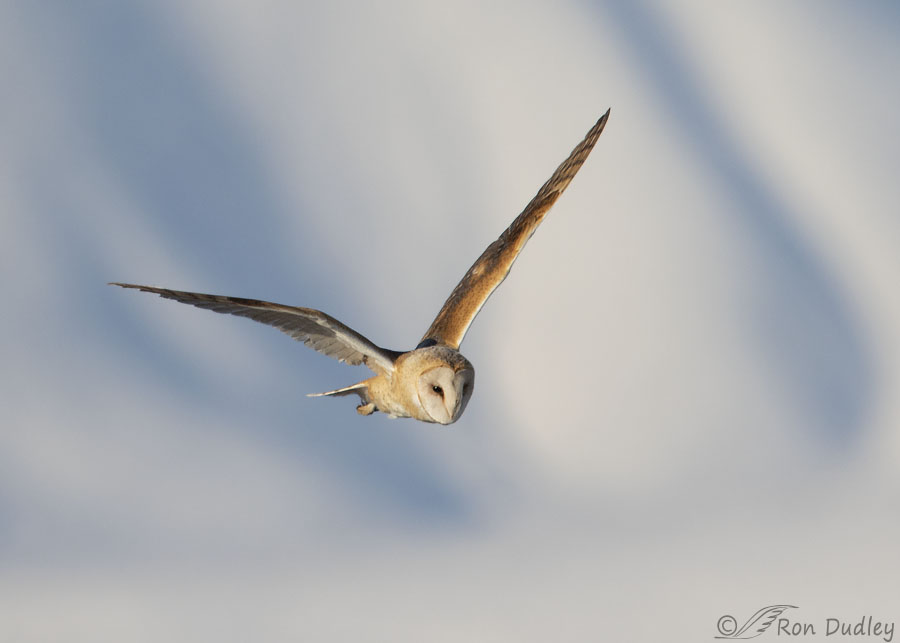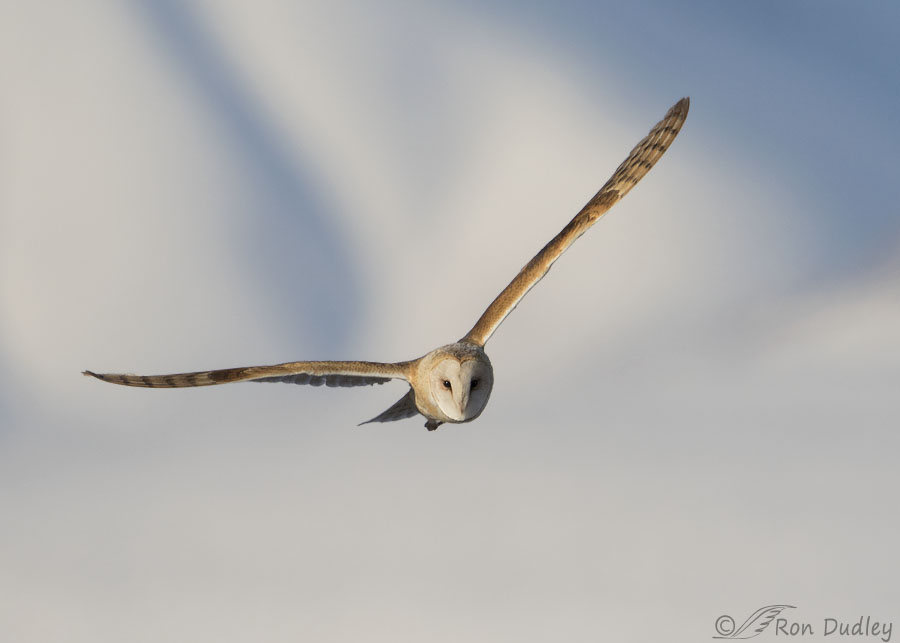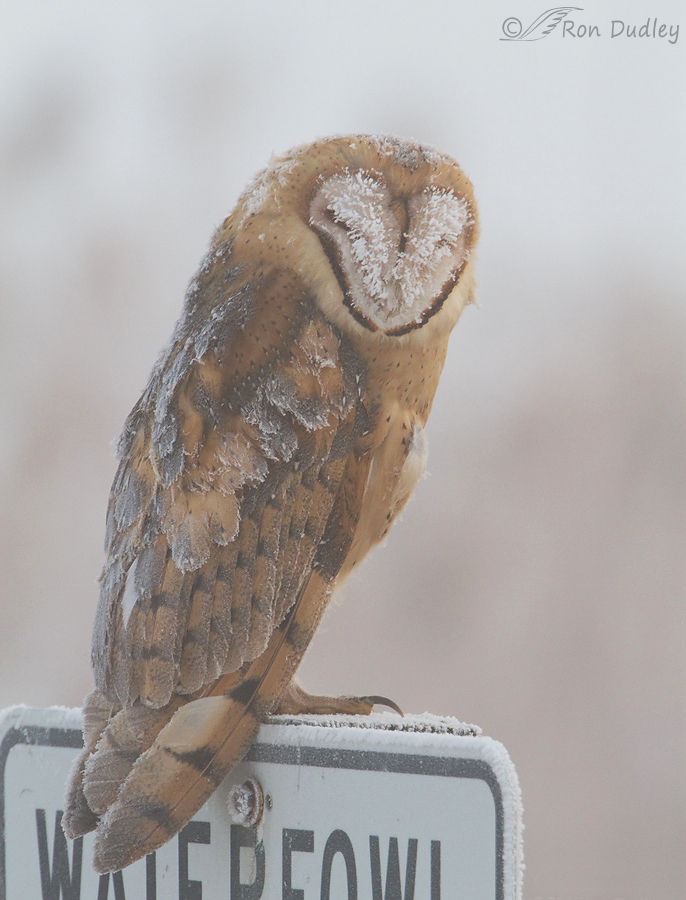Midwinter is Barn Owl “season” in northern Utah but it can also be an extremely grim time of year for them.
With rare exceptions Barn Owls don’t migrate so when we have cold snaps in January and February in northern Utah our resident owls often struggle to survive the harsh conditions. Under most circumstances Barn Owls are strictly nocturnal so they’re rarely seen out and about in daytime but intense cold and/or deep snow often forces them to extend their hunting hours so they become more crepuscular than strictly nocturnal. Occasionally I’ve even photographed them hunting at midday.

1/3200, f/6.3, ISO 500, Canon 7D Mark II, Canon EF 500mm f/4L IS II USM + EF 1.4 III Extender, not baited, set up or called in
I photographed this Barn Owl at 9:53 AM on January 26, 2016 as “he” hunted along the canal edges at Bear River MBR. He wasn’t particularly close when this shot was taken but he was cruising low and slow which allowed me to lock focus on him and get quite a few photos as he came closer. I’ve posted several of my other shots of him in the past but these two are new to my blog.
The background is the snow-covered Promontory Mountains in the far distance.

1/4000, f/6.3, ISO 500, Canon 7D Mark II, Canon EF 500mm f/4L IS II USM + EF 1.4 III Extender, not baited, set up or called in
Three shots later in the burst he was slightly closer, flying more in my direction and looking directly at me. Soon after this shot was taken he veered off to our left.
I always have mixed feelings when I have a Barn Owl in flight in my viewfinder. It goes without saying that I’m ecstatic – most folks never see a Barn Owl flying in daylight and I’m fully aware of how unique my experience is. But when a Barn Owl hunts in daylight it’s struggling to find enough food to survive the snow and/or frigid weather so my empathy for them runs deep. Barn Owls in stress break my heart.

Imagine trying to locate and capture enough voles to survive when the temperatures are freezing and the snow is deep. This photo was taken just after the owl had plunged into the snow after a vole. If I remember correctly this attempt was successful but with this much snow they usually fail.

I have my doubts whether this frost and snow-covered owl made it through the winter. This bird was actually shivering and I’ve seen several other shivering Barn Owls too. In these conditions it isn’t unusual to find a dead Barn Owl soon after a severe storm. I’m aware of one case where a struggling Barn Owl was rescued along the causeway to Antelope Island and delivered to rehab with a frostbitten face. Thankfully that owl survived and I believe it was eventually released back into the wild.
I don’t deny looking forward to photographing Barn Owls in flight this winter (if we get a cold snap in January or February) but if I had my druthers they’d never have to hunt in daylight. Not ever.
Ron


Beautiful photo but it breaks my heart.
Thanks, April.
Beauriful photos but they tug at your heart because of the reality them depict. In evolutionary terms, Barn Owls appear to be late arrivals to northern latitudes. As humans moved from southern habitats and began to form settlements, it appears that Barn Owls moved north soon after, following those human settlements, at least in Eurasia where the studies have been done. They didn’t evolve in cold climates and haven’t become fully adapted to severe cold as some other owls have. Long-distance migration isn’t an option for most owls. The feather structure in the wings allows for silent flight, but in order to achieve this, the trade-off is a less efficient flight, making long flight a struggle. Our one owl that does migrate long distance is the Flammulated Owl. It hunts insects and does not depend upon sound for successful hunting as do most other owls so it has stiffer wings that are not silent in flight. Some other species of owls do move in the winter but usually not great distances and in a series of short hops, not a single long flight. Deep snow can be very problematic for Barn Owls. Voles are active all year and the owls hear them beneath the snow. But, as the snow gets deeper it becomes more difficult for the owl to plunge through and capture its prey. Great Gray Owls are larger and can reach deeper into the snow than do Barn Owls.
Excellent summary explaining the situation, Dan. Apparently Barn Owls are almost completely absent from our northern tier of states (warmer Washington excluded) for good reason.
Heartbreakingly beautiful.
And yes, that poor shivering owl would haunt me.
Thanks, EC.
At the California Raptor Center, we were taught that Barn Owls have a thinner layer of fat, and possibly thinner skin as well, and so do not do tolerate cold temperatures. In handling them, I often thought that their undercoat of down feathers was not as thick as that of, say, a Great Horned Owl, but I never read anywhere that this was so. For sure, their legs and feet do not have the dense feathering of most of our other owl species. I live at 3,000 feet in Northern CA, where the weather may once in a blue moon get down in the teens. Mostly we have 40s and 30s, and we have no Barn Owls. They are in the Valley where the temperatures are generally not as low.
That’s fascinating, Sallie. I didn’t know that about their fat layer and potentially their skin.
Thoughtful and somber. Beautiful and tragic. Wild and free. Living life on their terms. Would they have it any other way? Still, it makes one’s heart heavy.
“Still, it makes one’s heart heavy.”
It sure does, Lyle. I couldn’t get the owl in that last photo out of my mind for a long time after that morning.
Mixed emotions on this post as expressed by others. Just makes me wonder why in their evolution they have not develop migratory patterns as have others, even raptors. Apparently they have been able to survive.
Frank, Barn Owls haven’t adapted for long distance flying. Migration is stressful and takes its toll in its own way so I suspect it’s more of an advantage to them overall to avoid its rigors.
A sad post with beautiful pictures! Thanks for educating me about the lives of these birds. Is their plight worse because of the climate change?
Thanks, Joanne. I could only guess at an answer to your question.
What a beautiful creature…surreal actually. I can almost feel the cold of your last photo…the frost in the air and on the owl. Your photo tugs at my heart. It is not an easy life out there…
Kathy, that last photo was taken years ago and I still remember how bitterly cold it was, even inside my pickup.
Today’s post is both beautiful and tragic.
Yup.
Beautiful, weird creatures they are….. Winter is hard on all creatures particularly when the snow is deep.
Winter is hard on all creatures particularly when the snow is deep.  Changing weather patterns certainly don’t help. Feb. last year for us was particularly brutal and many deer and at least one large hawk perished. Grit my teeth about shelter belt damage BUT can’t try and run anything off either…..
Changing weather patterns certainly don’t help. Feb. last year for us was particularly brutal and many deer and at least one large hawk perished. Grit my teeth about shelter belt damage BUT can’t try and run anything off either…..
“Beautiful, weird creatures they are”
I couldn’t agree more, Judy. For me they’re at the top of both lists.
Beautiful photos, Ron. Those wings are so elegantly shaped.
Elizabeth
Thank you, Elizabeth.
Your post and pictures once again illustrate just how brutal winters can be for our birds and other wildlife. Seems especially cruel for these Barn Owls who do all their normal hunting at night, but are now forced out into the daylight due to not be able to find anything at night. Your photo of the owl on the sign shows just how miserable it can be to be exposed to our freezing winter temperatures. I wrote an article called Nature is Cruel about the traumatic season our eagles had last year for our local Audubon periodical, and indeed nature can be very cruel. Thankfully there are people like yourself who are out there who often end up helping to rescue some of these birds and animals and assist in getting them to into rescue facilities. Thanks for posting this Ron.
Thanks, Everett. It’s a tough life out there for birds.